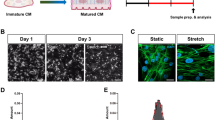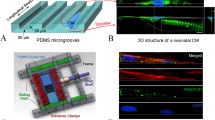Abstract
Cardiomyocytes possess the ability to respond to mechanical stimuli by reprogramming their gene expression. This study investigated the effects of different loading protocols on signaling and expression responses of myogenic, anabolic, inflammatory, atrophy and pro-apoptotic genes in cardiomyocyte-like H9C2 cells. Differentiated H9C2 cells underwent various stretching protocols by altering their elongation, frequency and duration, utilizing an in vitro cell tension system. The loading-induced expression changes of MyoD, Myogenin, MRF4, IGF-1 isoforms, Atrogin-1, Foxo1, Fuca and IL-6 were measured by Real Time-PCR. The stretching-induced activation of Akt and Erk 1/2 was also evaluated by Western blot analysis. Low strain (2.7% elongation), low frequency (0.25 Hz) and intermediate duration (12 h) stretching protocol was overall the most effective in inducing beneficial responses, i.e., protein synthesis along with the suppression of apoptosis, inflammation and atrophy, in the differentiated cardiomyocytes. These findings demonstrated that varying the characteristics of mechanical loading applied on H9C2 cells in vitro can regulate their anabolic/survival program.






Similar content being viewed by others
References
McCain ML, Parker KK (2011) Mechanotransduction: the role of mechanical stress, myocyte shape, and cytoskeletal architecture on cardiac function. Pflugers Arch 462(1):89–104. https://doi.org/10.1007/s00424-011-0951-4 Epub 2011 Apr 19. PMID: 21499986
Takahashi K, Kakimoto Y, Toda K, Naruse K (2013) Mechanobiology in cardiac physiology and diseases. J Cell Mol Med 17(2):225–232. https://doi.org/10.1111/jcmm.12027 PMID: 23441631; PMCID: PMC3822585
Palmieri EA, Benincasa G, Di Rella F, Casaburi C, Monti MG, De Simone G, Chiariotti L, Palombini L, Bruni CB, Saccà L, Cittadini A (2002) Differential expression of TNF-alpha, IL-6, and IGF-1 by graded mechanical stress in normal rat myocardium. Am J Physiol Heart Circ Physiol 282(3):H926–H934. https://doi.org/10.1152/ajpheart.00436.2001 PMID: 11834488
Dhein S, Schreiber A, Steinbach S, Apel D, Salameh A, Schlegel F, Kostelka M, Dohmen PM, Mohr FW (2014) Mechanical control of cell biology. Effects of cyclic mechanical stretch on cardiomyocyte cellular organization. Prog Biophys Mol Biol 115(2–3):93–102. https://doi.org/10.1016/j.pbiomolbio.2014.06.006 Epub 2014 Jun 28. PMID: 24983489
Cox L, Umans L, Cornelis F, Huylebroeck D, Zwijsen A (2008) A broken heart: a stretch too far: an overview of mouse models with mutations in stretch-sensor components. Int J Cardiol 131(1):33–44. https://doi.org/10.1016/j.ijcard.2008.06.049 Epub 2008 Aug 20. PMID: 18715658
Rysä J, Tokola H, Ruskoaho H (2018) Mechanical stretch induced transcriptomic profiles in cardiac myocytes. Sci Rep 8(1):4733. https://doi.org/10.1038/s41598-018-23042-w PMID: 29549296; PMCID: PMC5856749
Zhao L et al (2016) Deletion of Interleukin-6 attenuates pressure overload-induced left ventricular hypertrophy and dysfunction. Circ Res 118(12):1918–1929. https://doi.org/10.1161/CIRCRESAHA.116.308688 Epub 2016 Apr 28. Erratum in: Circ Res. 2020 Mar 27;126(7):e35. PMID: 27126808; PMCID: PMC4902783
Blaauw E et al (2009) Stretch-induced hypertrophy of isolated adult rabbit cardiomyocytes. Am J Physiol Heart Circ Physiol 299(3):H780–H787. https://doi.org/10.1152/ajpheart.00822.2009 Epub 2010 Jul 16. PMID: 20639217
Sheehy SP, Grosberg A, Parker KK (2012) The contribution of cellular mechanotransduction to cardiomyocyte form and function. Biomech Model Mechanobiol 11(8):1227–1239. https://doi.org/10.1007/s10237-012-0419-2 Epub 2012 Jul 7. PMID: 22772714; PMCID: PMC3786397
Lyon RC, Zanella F, Omens JH, Sheikh F (2015) Mechanotransduction in cardiac hypertrophy and failure. Circ Res 116(8):1462–1476. https://doi.org/10.1161/CIRCRESAHA.116.304937 PMID: 25858069; PMCID: PMC4394185
Chua SK et al (2016) Mechanical stretch inhibits MicroRNA499 via p53 to regulate Calcineurin-a expression in rat cardiomyocytes. PLoS One 11(2):e0148683. https://doi.org/10.1371/journal.pone.0148683 Erratum in: PLoS One. 2016;11(6):e0158257. PMID: 26859150; PMCID: PMC4747570
Mitsiades CS, Mitsiades N, Koutsilieris M (2004) The Akt pathway: molecular targets for anti-cancer drug development. Curr Cancer Drug Targets 4(3):235–256. https://doi.org/10.2174/1568009043333032 PMID: 15134532
Abilez OJ et al (2018) Passive stretch induces structural and functional maturation of engineered heart muscle as predicted by computational modeling. Stem Cells 36(2):265–277. https://doi.org/10.1002/stem.2732 Epub 2017 Nov 13. PMID: 29086457; PMCID: PMC5785460
Kaushik G, Engler AJ (2014) From stem cells to cardiomyocytes: the role of forces in cardiac maturation, aging, and disease. Prog Mol Biol Transl Sci 126:219–242. https://doi.org/10.1016/B978-0-12-394624-9.00009-9 PMID: 25081620; PMCID: PMC6281561
Pan J, Fukuda K, Saito M, Matsuzaki J, Kodama H, Sano M, Takahashi T, Kato T, Ogawa S (1999) Mechanical stretch activates the JAK/STAT pathway in rat cardiomyocytes. Circ Res 84(10):1127–1136. https://doi.org/10.1161/01.res.84.10.1127 PMID: 10347087
Spurthi KM et al (2018) Toll-like receptor 2 deficiency hyperactivates the FoxO1 transcription factor and induces aging-associated cardiac dysfunction in mice. J Biol Chem 293(34):13073–13089. https://doi.org/10.1074/jbc.RA118.001880 Epub 2018 Jun 21. PMID: 29929978; PMCID: PMC6109936
Zhang X, Tang N, Hadden TJ, Rishi AK (2011) Akt, FoxO and regulation of apoptosis. Biochim Biophys Acta 1813(11):1978–1986. https://doi.org/10.1016/j.bbamcr.2011.03.010 Epub 2011 Mar 31. PMID: 21440011
Glass DJ (2003) Signalling pathways that mediate skeletal muscle hypertrophy and atrophy. Nat Cell Biol 5(2):87–90. https://doi.org/10.1038/ncb0203-87 PMID: 12563267
Kopantseva EE, Belyavsky AV (2016) Key regulators of skeletal myogenesis. Mol Biol (Mosk) 50(2):195–222. https://doi.org/10.7868/S0026898416010079 PMID: 27239841
Karalaki M, Fili S, Philippou A, Koutsilieris M (2009) Muscle regeneration: cellular and molecular events. In Vivo 23(5):779–796 PMID: 19779115
Hirai H, Katoku-Kikyo N, Keirstead SA, Kikyo N (2013) Accelerated direct reprogramming of fibroblasts into cardiomyocyte-like cells with the MyoD transactivation domain. Cardiovasc Res 100(1):105–113. https://doi.org/10.1093/cvr/cvt167 Epub 2013 Jun 20. PMID: 23794713; PMCID: PMC3778960
Liu ST et al (2015) The regulatory mechanisms of myogenin expression in doxorubicin-treated rat cardiomyocytes. Oncotarget 6(35):37443–37457. https://doi.org/10.18632/oncotarget.5338 PMID: 26452256; PMCID: PMC4741940
Mutlak M, Kehat I (2015) Extracellular signal-regulated kinases 1/2 as regulators of cardiac hypertrophy. Front Pharmacol 6:149. https://doi.org/10.3389/fphar.2015.00149 PMID: 26257652; PMCID: PMC4513555
Honsho S et al (2009) Pressure-mediated hypertrophy and mechanical stretch induces IL-1 release and subsequent IGF-1 generation to maintain compensative hypertrophy by affecting Akt and JNK pathways. Circ Res 105(11):1149–1158. https://doi.org/10.1161/CIRCRESAHA.109.208199 Epub 2009 Oct 15
Philippou A, Halapas A, Maridaki M, Koutsilieris M (2007) Type I insulin-like growth factor receptor signaling in skeletal muscle regeneration and hypertrophy. J Musculoskelet Neuronal Interact 7(3):208–218
Stavropoulou A et al (2009) IGF-1 expression in infarcted myocardium and MGF E peptide actions in rat cardiomyocytes in vitro. Mol Med 15(5–6):127–135. https://doi.org/10.2119/molmed.2009.00012 Epub 2009 Mar 6. PMID: 19295919; PMCID: PMC2656994
Vinciguerra M, Santini MP, Claycomb WC, Ladurner AG, Rosenthal N (2009) Local IGF-1 isoform protects cardiomyocytes from hypertrophic and oxidative stresses via SirT1 activity. Aging (Albany NY) 2(1):43–62. https://doi.org/10.18632/aging.100107
Santini MP et al (2007) Enhancing repair of the mammalian heart. Circ Res 100(12):1732–1740. https://doi.org/10.1161/CIRCRESAHA.107.148791 Epub 2007 May 24. PMID: 17525368; PMCID: PMC3227120
Ezawa I et al (2016) Novel p53 target gene FUCA1 encodes a fucosidase and regulates growth and survival of cancer cells. Cancer Sci 107(6):734–745. https://doi.org/10.1111/cas.12933 Epub 2016 May 16. PMID: 26998741; PMCID: PMC4968591
Halapas A, Papalois A, Stauropoulou A, Philippou A, Pissimissis N, Chatzigeorgiou A, Kamper E, Koutsilieris M (2008) In vivo models for heart failure research. In Vivo 22(6):767–780 PMID: 19181005
Moustogiannis A et al (2020) Characterization of optimal strain, frequency and duration of mechanical loading on skeletal Myotubes' biological responses. In Vivo 34(4):1779–1788. https://doi.org/10.21873/invivo.11972 PMID: 32606147; PMCID: PMC7439881
Moorwood C et al (2014) Absence of γ-sarcoglycan alters the response of p70S6 kinase to mechanical perturbation in murine skeletal muscle. Skelet Muscle 4:13. https://doi.org/10.1186/2044-5040-4-13
Philippou A, Papageorgiou E, Bogdanis G, Halapas A, Sourla A, Maridaki M, Pissimissis N, Koutsilieris M (2009) Expression of IGF-1 isoforms after exercise-induced muscle damage in humans: characterization of the MGF E peptide actions in vitro. In Vivo 23(4):567–575 PMID: 19567392
Cheng WP, Wang BW, Lo HM, Shyu KG (2015) Mechanical stretch induces apoptosis regulator TRB3 in cultured cardiomyocytes and volume-overloaded heart. PLoS One 10(4):e0123235. https://doi.org/10.1371/journal.pone.0123235 PMID: 25898323; PMCID: PMC4405267
Besser RR, Ishahak M, Mayo V, Carbonero D, Claure I, Agarwal A (2018) Engineered microenvironments for maturation of stem cell derived cardiac myocytes. Theranostics 8(1):124–140. https://doi.org/10.7150/thno.19441 PMID: 29290797; PMCID: PMC5743464
Philippou A, Maridaki M, Halapas A, Koutsilieris M (2007) The role of the insulin-like growth factor 1 (IGF-1) in skeletal muscle physiology. In Vivo 21(1):45–54 PMID: 17354613
Juffer P et al (2014) Mechanical loading by fluid shear stress of myotube glycocalyx stimulates growth factor expression and nitric oxide production. Cell Biochem Biophys 69(3):411–419. https://doi.org/10.1007/s12013-013-9812-4 PMID: 2440267438
Philippou A, Maridaki M, Pneumaticos S, Koutsilieris M (2014) The complexity of the IGF1 gene splicing, posttranslational modification and bioactivity. Mol Med 20(1):202–214. https://doi.org/10.2119/molmed.2014.00011 PMID: 24637928; PMCID: PMC4022784
Lammerding J, Kamm RD, Lee RT (2004) Mechanotransduction in cardiac myocytes. Ann N Y Acad Sci 1015:53–70. https://doi.org/10.1196/annals.1302.005 PMID: 15201149.40
Buyandelger B et al (2014) Mechano-signaling in heart failure. Pflugers Archiv Eur J Physiol 466(6):1093–1099. https://doi.org/10.1007/s00424-014-1468-4
Ying H, Xu MC, Tan JH, Shen JH, Wang H, Zhang DF (2014) Pressure overload-induced cardiac hypertrophy response requires janus kinase 2-histone deacetylase 2 signaling. Int J Mol Sci 15(11):20240–20253. https://doi.org/10.3390/ijms151120240 PMID: 25380525; PMCID: PMC4264164
Jia L-X et al (2015) Mechanical stretch-induced endoplasmic reticulum stress, apoptosis and inflammation contribute to thoracic aortic aneurysm and dissection. J Pathol 236(3):373–383. https://doi.org/10.1002/path.4534
Kitamura, T., et al., (2007) A Foxo/notch pathway controls myogenic differentiation and fiber type specification. J Clin Invest. 117(9):2477–2485. doi: 10.1172/JCI32054. PMID: 17717603; PMCID: PMC1950461
Gumucio JP, Mendias CL (2012) Atrogin-1, MuRF-1, and sarcopenia. Endocrine 43(1):12–21. https://doi.org/10.1007/s12020-012-9751-7 Epub 2012 Jul 20. PMID: 22815045; PMCID: PMC3586538
Asfour HA, Allouh MZ, Said RS (2018) Myogenic regulatory factors: the orchestrators of myogenesis after 30 years of discovery. Exp Biol Med (Maywood) 243(2):118–128. https://doi.org/10.1177/1535370217749494 Epub 2018 Jan 7. PMID: 29307280; PMCID: PMC5788151
Tani H, Sadahiro T, Ieda M (2018) Direct cardiac reprogramming: a novel approach for heart regeneration. Int J Mol Sci 19(9):2629. https://doi.org/10.3390/ijms19092629 PMID: 30189626; PMCID: PMC6165160
Inagawa K, Ieda M (2013) Direct reprogramming of mouse fibroblasts into cardiac myocytes. J Cardiovasc Transl Res 6(1):37–45. https://doi.org/10.1007/s12265-012-9412-5 Epub 2012 Oct 3. PMID: 23054660
Pagano M, Naviglio S, Spina A, Chiosi E, Castoria G, Romano M, Sorrentino A, Illiano F, Illiano G (2004) Differentiation of H9c2 cardiomyoblasts: the role of adenylate cyclase system. J Cell Physiol 198(3):408–416. https://doi.org/10.1002/jcp.10420 PMID: 14755546
Huang W, Liu X, Chen R, Feng L, Liao H, Yu L, Zeng H (2012) [Effects of mechanical stretch with variant frequencies on alignment and differentiation of multilayer myotubes cultured in vitro]. Zhongguo Xiu Fu Chong Jian Wai Ke Za Zhi. 26(6):735–42. Chinese. PMID: 22792775
Abe S et al (2009) Effect of mechanical stretching on expressions of muscle specific transcription factors MyoD, Myf-5, myogenin and MRF4 in proliferated myoblasts. Anat Histol Embryol 38(4):305–310. https://doi.org/10.1111/j.1439-0264.2009.00945.x PMID: 19614631
Acknowledgments
We are grateful to Dr. Panagiotis Lembessis, National and Kapodistrian University of Athens, for the critical reading of the manuscript.
Funding
The Authors declare that no external or extramural support was provided and funding was exclusively through the Department of Physiology, Medical School, National and Kapodistrian University of Athens.
Author information
Authors and Affiliations
Contributions
EZ designed and performed the experiments, analyzed the data and wrote the manuscript; AP and MK conceived or designed the experiments, analyzed data and wrote the manuscript; AM performed the experiments and analyzed the data; AC analyzed data and reviewed the manuscript. All Authors have read and approved the final manuscript.
Corresponding author
Ethics declarations
Conflict of interest
The Authors declare no conflicts of interest.
Additional information
Publisher's Note
Springer Nature remains neutral with regard to jurisdictional claims in published maps and institutional affiliations.
Rights and permissions
About this article
Cite this article
Zevolis, E., Philippou, A., Moustogiannis, A. et al. Optimizing mechanical stretching protocols for hypertrophic and anti-apoptotic responses in cardiomyocyte-like H9C2 cells. Mol Biol Rep 48, 645–655 (2021). https://doi.org/10.1007/s11033-020-06112-z
Received:
Accepted:
Published:
Issue Date:
DOI: https://doi.org/10.1007/s11033-020-06112-z




